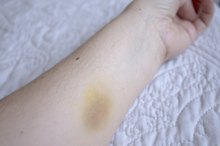How to Treat Muscles Pulled From Bones
Injuries that cause a muscle to pull away completely from the bone are called tendon avulsion injuries 1. In this case, the tendon that holds the muscle to the bone is detached. Because they contain no blood vessels, tendons heal slowly after being injured in any way. Non-surgical treatment of muscles pulling from the bone includes rest, ice, compression and elevation (known as RICE). However, in cases of severe injury, surgery is required to re-attach the tendon.
If you are experiencing serious medical symptoms, seek emergency treatment immediately.
Rest. Take a break from whatever you were doing to cause your injury. Depending on where the tendon avulsion injury occurred, your doctor may require you to wear a supportive device such as a brace, cast, splint or crutches to keep the injured area in a neutral position and allow it to heal.
Torn Tendons & Ligaments From Hyperextension
Learn More
Ice your injury. Apply cold packs for up to 20 minutes at a time, three to five times each day.
Compress the area of the injury to prevent more swelling and/or blood loss. An elastic compression bandage should be wrapped snugly (but not too tightly) around the injury.
How to Rehab a Suspensory Strain
Learn More
Elevate the injury. Depending on the location of the injury, another way to reduce swelling is to lay back and keep your injured area higher than your heart.
Perform the rehabilitation exercises recommended by your doctor if your injury is not severe and after the pain and swelling has calmed down. Initial therapy, such as gentle stretching, first focuses on flexibility and aims to restore range of motion. Later, more exercises can be incorporated to build up strength which also helps in the healing process. Therapy will also be required after corrective surgery.
Undergo surgery. To repair a tendon avulsion injury, a surgeon must pull the muscle back into place and remove any scar tissue. The tendon is then reattached to the bone using large stitches or staples.
Warnings
When icing your injury, do not apply ice directly on the skin.
If surgery is performed to treat your injury, you must keep the injured area stable to speed up recovery and prevent further injury .
Related Articles
References
- Hamstring Muscle Injuries
- Vannabouathong C, Ayeni OR, Bhandari M. A Narrative Review on Avulsion Fractures of the Upper and Lower Limbs. Clin Med Insights Arthritis Musculoskelet Disord. 2018;11:1179544118809050. doi:10.1177/1179544118809050
- Frush TJ, Lindenfeld TN. Peri-epiphyseal and Overuse Injuries in Adolescent Athletes. Sports Health. 2009;1(3):201-11. doi:10.1177/1941738109334214
- Bowes J, Buckley R. Fifth metatarsal fractures and current treatment. World J Orthop. 2016;7(12):793-800. doi:10.5312/wjo.v7.i12.793
- Jarraya M, Hayashi D, Roemer FW, et al. Radiographically occult and subtle fractures: a pictorial review. Radiol Res Pract. 2013;2013:370169. doi:10.1155/2013/370169
- Schiller J, DeFroda S, Blood T. "Lower Extremity Avulsion Fractures in the Pediatric and Adolescent Athlete" J Am Acad Orthop Surg. 2017 Apr;25(4):251-259.
Warnings
- When icing your injury, do not apply ice directly on the skin.
- If surgery is performed to treat your injury, you must keep the injured area stable to speed up recovery and prevent further injury .
Writer Bio
Laura Shapiro has been a writer all her life. In the most recent past she focused on technical articles for Artech Publishing in Milan, Italy, and is currently writing about a variety of topics for One Article a Day and Demand Studios.









